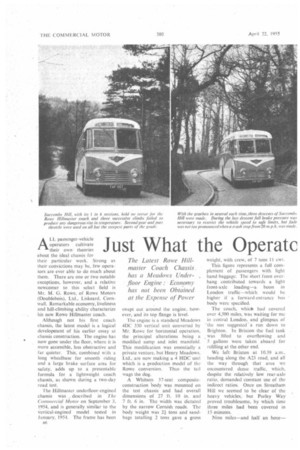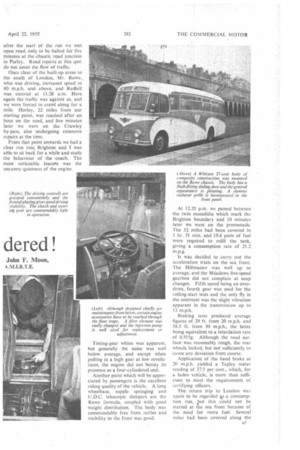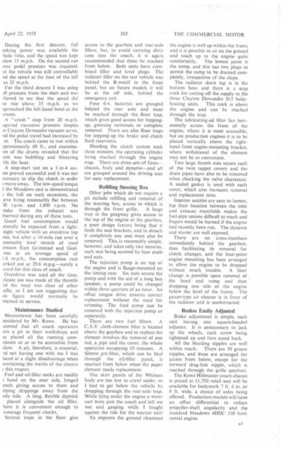Just What the Operatc
Page 40

Page 41

Page 42

Page 43

If you've noticed an error in this article please click here to report it so we can fix it.
ALL passenger-vehicle operators cultivate their own theories about the ideal chassis for their particular work. Strong as their convictions may be, few operators are ever able to do much about them. There are one or two notable exceptions, however, and a relative newcomer to this select field is Mr. M. G_ Rowe, of Rowe Motors (Doublebois), Ltd., Liskeard, Cornwall. Remarkable economy, liveliness and hitl-climbing ability characterize his new Rowe Hillrnaster coach.
Although not his first coach chassis, the latest model is a logical development of his earlier essay at chassis construction. The engine has . now gone under the floor, where it is more accessible, less obstructive and far quieter. This, combined with a long wheelbase for smooth riding and a large brake surface area for safety, adds up to a presentable formula for a lightweight coach chassis, as shown during a two-day road test.
The Hillmaster underfloor-engined chassis was described in The Commercial Motor on September. 3, 1954, and is generally similar to the vertical-engined model tested in January, 1954. The frame has been
swept out around the engine, however, and its top flange is level.
The engine is a standard Meadows 4DC 330 vertical unit converted by Mr. Rowe for horizontal operation, the principal alterations being a modified sump and inlet manifold. This modification was essentially a private venture, but Henry Meadows, Ltd., are now making a 4 HDC unit which is a production model of the Rowe conversion. Thus the tail wags the dog.
A Whitson 37-seat compositeconstruction 'body was mounted on the test chassis and had overall dimensions of 27 ft. 10 in. and 7 ft. 6 in. The width was dictated by the narrow Cornish roads. The body weight was 24 tons and sandbags totalling 2 tons gave a gross weight, with crew, of 7 tons 11 cwt.
This figure represents a full complement of passengers with light hand baggage. The short front overhang contributed towards a light front-axle loading—a boon in London traffic—which would be higher if a forward-entrance bus body were specified.
The coach, which had covered over 4,500 miles, was waiting for me in central London, and glimpses of the sun suggested a run down to Brighton. In Brixton the fuel tank was filled to overflowing and 5 gallons were taken aboard for refilling at the other end.
We left Brixton at 10.39 a.m.. heading along the A23 road, and all the way through that area we encountered dense traffic, which, despite the relatively low rear-axle ratio, demanded constant use of the indirect ratios. Once on Streatham Hill we seemed to be clear of the heavy vehicles, but Purley Way proved troublesome, by which time three miles had been covered in 15 minutes.
Nine miles—and half an hour
Timing-gear whine was apparent, but generally the noise was well below average, and except when pulling in a high gear at low revolutions, the engine did not betray its presence as a four-eylindered unit. Another point which will be appreciated by passengers is the excellent riding quality of the vehicle. A long wheelbase, supple springing and U.D.C. telescopic dampers are the Rowe formula, coupled with good weight distribution. The body was commendably free from rattles and visibility to the front was good.
At 12.20 p.m. we passed between the twin monoliths which mark the Brighton boundary and 10 minutes later we were on the promenade. The 52 miles had been covered in 1 hr. 51 min_ and 19.6 pints of fuel were required to refill the tank,
giving a consumption rate of 21.2 m.p.g. It was decided to carry. out the acceleration trials on the sea front. The Hillmaster was well up to average, and the Meadows five-speed gearbox did not complain at snap changes. Fifth speed being an overdrive, fourth gear was used for the rolling-start tests and the only fly in the ointment was the slight vibration
apparent in the transmission up to 12 m.p.h.
Braking tests produced average figures of 29 ft. from 20 m.p.h. and 58.5 ft. from 30 m.p.h., the latter being equivalent to a retardation rate of 0.515g. Although the road surface was reasonably rough, the rear wheels locked, but not sufficiently to cause any deviation from course. Application of the hand brake at 20 m.p.h. yielded a Tapley meter reading of 27.5 per cent., which, for a laden vehicle, is more than sufficient to meet the requirements of certifying officers. The return trip to London was again to be regarded 4,s a consump
tion run, but this could not be started at the sea front because of the need for more fuel. Several
miles had been covered along the
A23 road before we found a garage which retailed oil fuel, and so the run was started from that point at 4.54 p.m.
This time the roads were much clearer and tile coach was taken up to 50 m.p.h. on numerous occasions. "Honey, 5.25 p.m.; Redhill, 5,33 p.m. and Purley, 5.54 p.m." ran the log, but the next 10 miles took nearly an hour to cover. Exceptionally heavy traffic was encountered and the indirect ratios were used for 54 minutes of the last hour. It is not surprising that, in view of the high speeds during the early part of the run and the extensive gear work during the later part, the fuelconsumption rate should be higher than on theittward run.
Even so, 17.4 m.p.g. Is a reasonable figure, the average speed being 26.9 m.p.h. On the double trip 100 miles were covered at an average
B8 speed of 27.6 m.p.h. and a consumption rate of 19.3 m.p.g.
On the second day of the test I decided to try the Hillmaster's performance on a steep hill, and the obvious choice was Succombs Hill, in Surrey. This hill is mile long, with two sharp bends near the summit, and has a general gradient of I in 43. There are two sections of 1 in 4, one of these being on the railway bridge at the lower end and the other lying on the first bend.
Ambient temperature during the test was 51 F., and a bulb thermometer connected to the radiator header tank registered 140° F. before the climb was started. Second gear was used for the lirst section, but the engine speed dropped rapidly at the bridge and low gear was engaged with the vehicle almost at a standstill. " Second" was reverted to once past the bridge, but on the other 1-in-4 section low ratio became necessary, and this gear was held until the hill had been breasted. When pulling in second gear on the less severe gradient, only quarter throttle was necessary to keep the coach moving, and we kept the speed down in an attempt to raise the coolant temperature.
At the top, however, it was the same as at the bottom, so I took the Rowe up the hill twice more, using second gear on all but the steepest sections. At the end of the third climb the thermometer showed a reading of 160' F., which indicated adequate cooling for this kind of work in temperatures above 95° F.
knew the brakes were good, so I made three descents of the hill on the brakes alone with the gear in neutral. This is not a recommended practice, but a sure way of detecting any braking weakness! During the first descent, full raking power was available the bole time, and the speed was kept elow 15 m.p.h. On the second run lore pedal presgure was required, ut the vehicle was still controllable rid the speed at the foot of the hill as 25 m.p.h.
For the third descent I was using ill pressure from the start and was dieved to see that the speed did ot rise above 35 m.p.h. as we pproached the left-hand bend at the ottom.
A " crash " stop from 20 m.p.h. :quire(' excessive pressure despiteie Clayton Dcwandre vacuum servo, ad the pedal travel had increased by in. The coach came to rest within pproximately 60 ft., and examinaon of the drums revealed that the lint was bubbling and blistering ith the heat, A stop-start test on a 1-in-4 secon proved successful and it was not ocessary to slip the clutch in order move away. The low-speed torque f the Meadows unit is demonstrated the full on such occasions, the irve being reasonably flat between )0 r.p.m. and 1,800 r.p.m. No nokc from the exhaust was bserved during any of these tests. Good fuel consumption would aturally be expected from a light, eight vehicle with an overdrive top itio, but after a 10-mile run over a asonably level stretch of road ,tween East Grinstead and Godone at an average speed of 1.6 m.p.h., the consumption rate orked out at 29.6 m.p.g.—surely a !cord for this class of coach.
Overdrive was used all the time, 2licate use was made of the throttle id the road was clear of other affic, so I am not suggesting that us figure would normally be stained in service.
Maintenance Studied
Maintenance has been carefully msidered by Mr. Rowe. He has
isumed that all coach operators ive a pit in their workshops and is placed all the running comments so as to be accessible from elow. A pit, therefore, is essential, id not having one with me T was laced at a slight disadvantage when ;certaining the merits of the chassis
this respect.
Fuel and oil-filler necks are readily hand on the near side, hinged Inch giving access to them and piping drippings away from the ody side. A long, flexible dipstick placed alongside the oil Her, -here it is convenient enough to icourage frequent checks.
Several traps in the floor give access to the gearbox and rear-axle fillers, but, to avoid carrying dirty cans into the coach, it is again recommended that these be reached from below. Both units have combined filler and level plugs. The radiator filler on the test vehicle was behind the R-motif in the front panel, but on future models it will be at the off side, behind the emergency exit.
Four 6-v. batteries are grouped behind the rear axle and must be reached through the .floor trap, which gives good access for toppingup, greasing terminals or complete removal. There are also floor traps for topping-up the brake and clutch fluid reservoirs.
Bleeding the clutch system took three minutes. the operating cylinder be:ng reached through the engine trap. There are three sets of fuses— chassis, body and dynamo—and all are grouped around the driving seat for easy replacement.
Refilling Steering Box
Other jobs which do not require a pit include refilling and removal of the steering box, access to which is through the front grille. A large trap in the gangway gives access to the top of the engine or the gearbox, a poor design feature being that it fouls the seat brackets, and to detach it completely one seat must also be removed. This is reasonably simple, however, and takes only two minutes, each seat being secured by four studs and nuts.
The injection pump is on top of the engine and is flange-mounted on the timing case. Six nuts secure the pump and with the aid of a long box spanner, a pump could be changed within three quarters of an hour. An offset tongue drive ensures correct replacement without the need for retiming. The feed pump can be removed with the injection pump or separately.
There are two fuel filters. A C.A.V. cloth-element filter is located above the gearbox and to replace the element involves the removal of one nut, a pipe and the cover, the whole operation occupying 10 minutes. A Simms pre-filter, which can be bled through the oil-filler panel, is reached from below when the paper element needs replacement.
The skirt panels of the Whitson body are too low to crawl under, so. I had to get below the vehicle by dropping through the rear-axle trap.
While lying under the engine a water cart went past the coach and left me wet and gasping while I fought against the tide for the nearest exit! To improve the ground clearance the engine is well up within the frame and it is possible to sit on the ground and reach up to the engine quite comfortably. The lowest point is the sump, and this has two plugs to permit the sump to be drained completely, irrespective of the slope.
The radiator drain tap is in the bottom hose and there is a stop cock for cutting off the supply to the three Clayton Dewandre S12 body heating units. This cock is above the engine and can be reached through the trap.
The lubricating-oil filter lies horizontally across the front of the engine, where it is most accessible, but on production engines it is to be placed vertically above the righthand front engine-mounting bracket, where withdrawal of the element may not be so convenient.
Two large thumb nuts secure each of the twin tappet covers and the drain pipes have also to be removed when checking the valve clearances. A sealed gasket is used with each cover, which also increases removal and replacement time.
Injector nozzles are easy to loosen, but their location between the inlet and exhaust manifolds makes the fuel-pipe unions difficult to reach and fingers would be burned if the engine had recently been run. The dynamo and starter are well exposed.
There are no cross-members immediately behind the gearbox, thus facilitating its removal for clutch changes, and the four-point engine mounting has been arranged to allow the engine to be dropped without much trouble. A liner change is possible upon removal of the head and sump and then dropping one side of the engine below the level of the frame. The gauze-type air cleaner is in front of the radiator and is unobstructed.
Brakes Easily Adjusted
Brake adjustment is simple, each unit having one square-headed adjuster. It is unnecessary to jack up the wheels, each screw being tightened up and then eased back.
All the bleeding nipples are well within reach. There are 30 grease nipples, and these are arranged for access from below, except for the forward drag-link nipple, which is reached through the grille aperture.
The Rowe Hillmaster coach chassis is priced at £1,750 retail and will be available for bodywork 7 ft. 6 in. or g ft. wide, a choice of axles being offered. Production models will have an offset -differential to reduce propeller-shaft angularity and the standard Meadows 4HDC 330 horizontal engine.




























































































